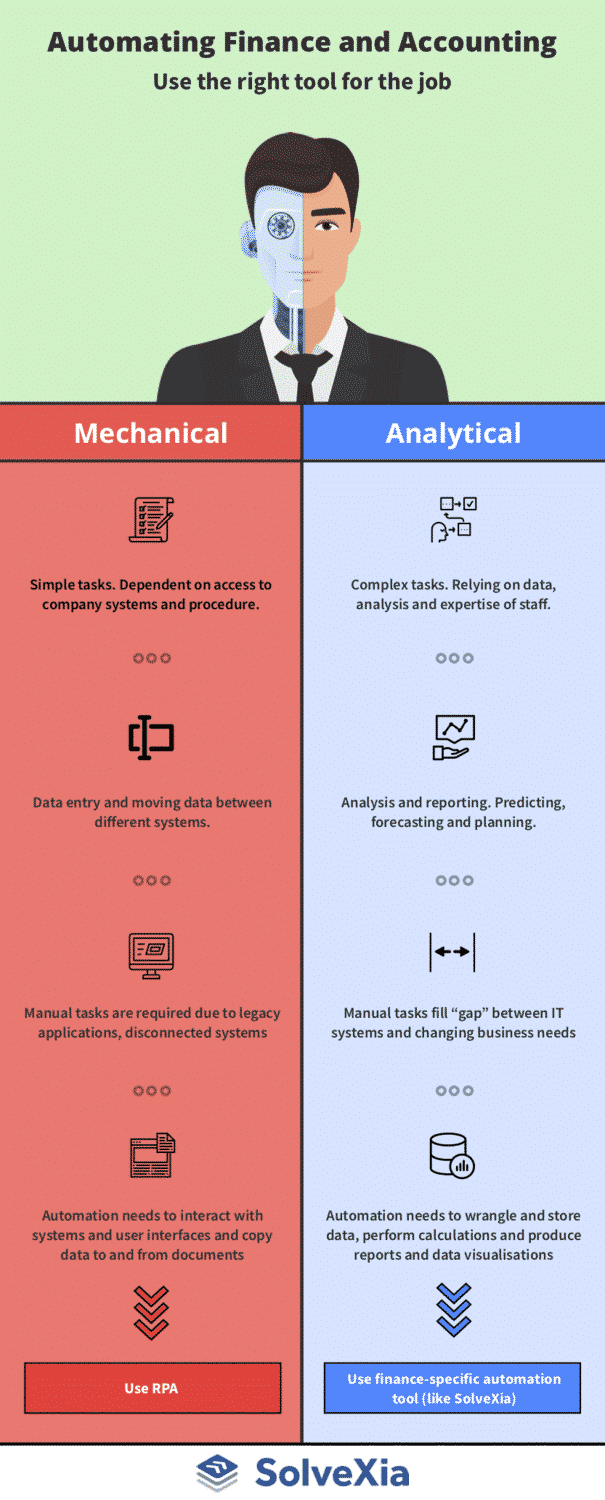The 2 types of finance work. An antidote for RPA buyer's remorse.

By 2021, at least 40% of companies will have RPA buyer's remorse (Gartner), caused by:
- Hype and evangelism from vendors and service providers; and
- Misaligned priorities and unrealistic expectations from companies.
To avoid buyer's remorse, CFOs need to have a clear understanding of when to use RPA vs. other, finance-specific, tools. Consider splitting the work finance staff do into two categories:
- Mechanical - Tasks that are simple and dependent on accessing company systems and procedure.
- Human/Analytical - Tasks that are more complex and reliant on data, analysis and the expertise of staff.
Mechanical work is ideal for RPA. Human/Analytical finance work needs tools that are better suited to ingest, interpret and analyse data.
The accountant. Part-machine. Part-human.
Finance staff act as both a machine and a human in most organisations:

When acting as the machine, staff perform simple tasks focused on getting data in and out of systems. When acting as the human, staff rely on their expertise and knowledge to analyse data and communicate insights.
Most, if not all, finance staff spend their day as part-machine, part-human. The split between machine and human will vary from company to company.
Both mechanical and human/analytical work can leverage automation. However, it is important that finance leaders understand the difference between the two types of work and choose the right tool for the job.
Mechanical work is ideal for RPA.

The mechanical side of the finance worker performs tasks that are low-value, simple and repetitive. The types of work that falls into this category include:
- Getting data into or between systems.
- Pasting data into reports (e.g. Excel).
- Basic "if-this-then-that" workflow.
Around 76% of companies say their data is trapped in their legacy applications. As a result, staff need to manually move data from one system to another. Some examples of work that falls into this category include:
- Example 1: Preparing cash flow statements by extracting data from a bank statement.
- Example 2: Reconciling balances in the GL and alerting staff for variances.
- Example 3: Copying information from scanned invoices into the accounts payable system.
This work is ideal for automation using RPA tools. The ROI for this type of work comes with the ability to scale an RPA solution - i.e. automate a simple data entry task for 100 employees.
Automating mechanical work.

Mechanical tasks can be performed by anyone that has:
- Access to the systems; and
- An ability to follow a procedure.
The procedural nature of these tasks reduces the need for subject matter expertise. As a result, these tasks can more easily be packaged, transferred or even off-shored.
To automate mechanical tasks, the tool must have an ability to:
- Open and log into systems.
- Interact with user interfaces.
- Connect to and query databases.
- Copy data to and from documents (spreadsheets, Word, PDF, etc.).
- Extract text from scanned documents, images and natural-language.
This functionality sits squarely in the domain of RPA tools. Companies may also combine their RPA tools with other tools for OCR and natural-language processing.
Human/analytical work requires different tools.

In contrast, the human side of the finance worker focuses on tasks that are analytical and of higher value to the company. The human side of finance work relates to tasks such as:
- Analysis and reporting for key stakeholders (management, regulators, partners, customers).
- Predicting, forecasting and planning.
The reason why this type of work occurs manually is because most IT systems are not able to keep up with changes in the business and regulatory environment. Finance staff often "plug the gap" with spreadsheets, scripts and manual processes. This is sometimes referred to as "shadow IT". Examples include:
- Example 1: Combining ticket data and commission rules to forecast airline commissions for a travel agency.
- Example 2: Consolidating and validating life insurance policy data into a single format to produce extracts for downstream actuarial modelling.
- Example 3: Analysing GL, budget and procurement data to determine committed spend for cost centres in a company.
This type of work requires a tool that can ingest and analyse data and align with the business knowledge and expertise of finance staff. There is less emphasis on scaling an individual process or task to achieve an ROI for automation. This is because individual human/analytical tasks typically have higher value and do not need to be done hundreds or thousands of times to justify an investment in automating them, provided a tool suitable for such tasks is used.
Automating human/analytical work.

To do human/analytical work, staff must posses a strong understanding of:
- The business, regulatory and customer environment that drives their process; and
- The data that they are working with.
For this reason, it is critical that SMEs remain close to this work. This means that they must act as either the operator or the administrator of any automation. To automate human/analytical work in finance, a tool must have an ability to:
- Wrangle data. This includes aggregating, mapping, cleansing, transforming and validating large volumes of data.
- Perform calculations using formulae.
- Apply advanced analytics and predictive modelling.
- Store data for historical reporting and trend analysis.
- Generate reports and data visualisations.
- Allow for human-interaction and workflow by making use of email approvals and by capturing commentaries.
Finance-specific process automation tools like SolveXia offer these features. The key differentiation from RPA is the focus on data and business process knowledge (as opposed to system interaction).
The right tool(s) for the job.
In summary, CFOs and finance leaders need to prevent RPA buyer’s remorse for their company. Finance work is either mechanical or human/analytical and companies must choose the right tool for each job.
Mechanical work is simple and focuses on moving data into or between systems. As such, RPA tools are ideal for this type of work, with functionality that focuses on:
- Logging into and interacting with systems.
- Copying and pasting data into and from documents.
- OCR and data extraction by leveraging third-party tools.
Human/analytical work relates to higher-value tasks that require staff to combine and analyse data in accordance with their deep understanding of the business, regulations and customers. Human/Analytical work requires:
- Data wrangling (combine, cleanse, transform and validate).
- Calculations and advanced analytics.
- Reporting and data visualisation.
- Human-interaction for workflow and capturing commentaries.
Many organisations use a combination of both RPA and finance-specific tools (often cloud / SaaS products - like SolveXia). This approach can often yield fantastic benefits for the finance department, allowing them to achieve end-to-end automation whereby:
- The RPA tool extracts data from legacy systems and loads them into the cloud/SaaS tool; and
- The cloud/SaaS tool ingests the data and produces the analysis required.

FAQ
Intelligent reconciliation solution
Intelligent rebate management solution
Intelligent financial automation solution
Intelligent Financial Automation Solution
Intelligent financial automation solution
Intelligent financial automation solution
Intelligent financial automation solution
Intelligent financial automation solution
Intelligent regulatory reporting solution
Free up time and reduce errors
Recommended for you

Request a Demo
Book a 30-minute call to see how our intelligent software can give you more insights and control over your data and reporting.

Reconciliation Data Sheet
Download our data sheet to learn how to automate your reconciliations for increased accuracy, speed and control.

Regulatory Reporting Data Sheet
Download our data sheet to learn how you can prepare, validate and submit regulatory returns 10x faster with automation.

Financial Automation Data Sheet
Download our data sheet to learn how you can run your processes up to 100x faster and with 98% fewer errors.

Financial Automation Data Sheet
Download our data sheet to learn how you can run your processes up to 100x faster and with 98% fewer errors.

Financial Automation Data Sheet
Download our data sheet to learn how you can run your processes up to 100x faster and with 98% fewer errors.

Financial Automation Data Sheet
Download our data sheet to learn how you can run your processes up to 100x faster and with 98% fewer errors.

Financial Automation Data Sheet
Download our data sheet to learn how you can run your processes up to 100x faster and with 98% fewer errors.

Financial Automation Data Sheet
Download our data sheet to learn how you can run your processes up to 100x faster and with 98% fewer errors.

Rebate Management Data Sheet
Download our data sheet to learn how you can manage complex vendor and customer rebates and commission reporting at scale.

Top 10 Automation Challenges for CFOs
Learn how you can avoid and overcome the biggest challenges facing CFOs who want to automate.
.svg)



